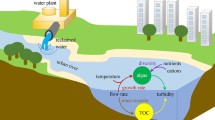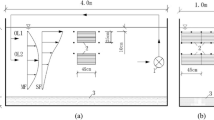Abstract
This research studies the impact of water level control structures on self-assimilative capacity of rivers and on fish habitat. Constructing a water level control structure in a river reach will alter its hydraulics as well as its water quality, thermal regime and fish habitat. A mathematical model is developed to simulate river hydraulics, water quality, temperature and fish habitat. Diurnal dissolved oxygen concentrations are investigated to show their impact on fish. A case of a Nile River reach was studied to investigate the impact of the existence of the Esna barrage on the water quality and fish in its upstream reach. The barrage has negative impacts on the upstream self-assimilative capacity of the rivers. The waste load that the river could absorb was only 54 % (at low flow) and 78 % (at high flow) of the entire load if no barrage was present. Including in the simulation of the effects of photosynthesis and respiration, the above mentioned percentages were raised to 54 % and 91 %, respectively. Although water level control structures have negative impacts on the upstream self-assimilative capacity of the rivers, they have positive effect on downstream dissolved oxygen concentrations due to reaeration that happens across them. Downstream dissolved oxygen concentration increased by 6 % from its upstream concentration value. The barrage has a positive effect on fish habitat in the upstream section. The weighted usable area of Tilapia fish is doubled in case of barrage existence. The barrage causes a slight decrease in water temperature that reaches an average of 0.13 degree in the month of June.
Similar content being viewed by others
References
Abdelbary, M., (1992). River regime of the Nile river, Arab Republic of Egypt. Ministry of Public Works and Water Resources, Water Research Center, Nile Research Institute, Canadian International Development Agency.
ADEM, (2001). The ADEM spreadsheet water quality model. Alabama Department of Environmental Management, Water Division-Water Quality Branch.
Barbie, D. L.; Gandara, S. C., (1999). Water resources data Texas. U.S Geological Survey-water data, ReportTx-99-4, 4.
Chapra, S., (1997). Surface water quality modeling. McGraw-Hill International, 265–268.
Chou, W., (1988). Open-channel hydraulics. McGraw-Hill publishing company.
Eid, D. M., (1992). Impact of flow control structures on rivers self purification capacity. Dissertation. The American University in Cairo.
El Baradei, S. A., (2005). Impact of control structure on ecosystem and assimilative capacity of rivers. Dissertation. Cairo University: Faculty of Engineering.
EPA, (2003). Environmental Protection Agency, Computer package: QUAL2E, EPA.
French, R. H., (1985). Open channel hydraulics. McGraw-Hill Book Company, 164–182.
Goldsmith, E.; Hildyard, N., (1986). The social and environmental effects of large dams. San Francisco: Sierra Club Books.
Group work, (1997). Sacramento river temperature modeling project. Center for Environmental and Water Resources Engineering, Department of Civil and Environmental Engineering, Modeling Group. University of California, Davis Report No. 97–01.
Habitat modeling, (2002). Available from: http://www.educ.sfu.ca/nbcr/tempprot.html
Hepher, B., (1981). Commercial fish farming. John Willy and Sons, Inc. Idaho, (2004). Idaho’s Water Quality Standards, State of Idaho, Department of Environmental Quality. Available from: http://www.deq.state.id.us/water/water_temp.htm.
Imam, E., El Baradei, S., (2006). Ecosystem and assimilative capacity of rivers with control structure. 8thconference on modelling, measuring and prediction of water pollution. September 4, Italy. DOI: 10.2495/WP060431.
Jacobs, A. F. G., (1994). Diurnal temperature variation in shallow water pool. Department of Meteorology, Wageningen Agricultural University, Duivendaal 2, NL-6701 AP Wageningen.
John, R. D., (1984). Water temperature change caused by abstraction. J. Hydraul. Eng., 110(7), 987–991 (5 pages).
McCully, P., (2001). Silenced rivers, the ecology and politics of large dams. New York. Zed Books.
McDonnell, A. J.; Wright, R. M., (1979). In-stream deoxygenation rate prediction. J. Environ. Eng., Div-ASCE, 105(2), 323–335 (13 pages).
Moffat, A. I. B.; Nalluri, C.; Novak, P., (1990). Hydraulic structures. Cambridge University press, 271–289.
Murphy, S., (1987). Diurnal variations of water quality parameters in boulder Creek. City of Boulder/USGS water quality monitoring.
Neumann, D. W., (2003). Regression model for daily maximum stream temperature. J. Environ. Eng., 129(7), 667–674 (8 pages).
Pilgrim, J. M.; Xing, F.; Stefan, H. G., (1998). Stream temperature correlations with air temperatures in Minnesota: Implications for climate warming. Water Resour. Bull., 34(5), 1109–1121 (13 pages).
Shanahan, P., (1984). Water temperature modeling: A practical guide. Proceedings of Stormwater and Water Quality Model Users Group meeting.
Sinokrot, B. A.; Heinz, S. G., (1994). Stream water-temperature sensitivity to weather and bed parameters. J. Hydraul. Eng. ASCI, 120(6), 722–736 (15 pages).
Song, C. C. S.; Pabst, A. F.; Bowers, C. E., (1973). Stochastic analysis of air and water temperatures., J. Env. Eng., 99(6), 785–800 (16 pages).
Song, C. C. S.; Chien, C. Y., (1977). Stochastic properties of daily temperature in rivers. J. Env. Eng., 103(2), 217–231 (15 pages).
Stefan, H. G.; Preud’homme, E. B., (1993). Stream temperature estimation from air temperature. Water Resour. Bull., 29(1), 27–47 (21 pages).
Thomann, R. V.; Mueller, J. A., (1987). Principles of surface water quality modeling and control. Harper Collins, 231, 599–621.
Wright, S. A.; Holly, F. M. Jr.; Krajewski, W.; Bradley, A. A., (1999). Long-Term Simulation of Thermal Regime of Missouri River. J. Hydraul. Eng., 125(3), 242–252 (11 pages).
Author information
Authors and Affiliations
Corresponding author
Rights and permissions
About this article
Cite this article
Imam, E.H., El Baradei, S.A. Impact of control structures on assimilative capacity of rivers and fish habitat. Int. J. Environ. Sci. Technol. 6, 315–324 (2009). https://doi.org/10.1007/BF03327635
Received:
Revised:
Accepted:
Published:
Issue Date:
DOI: https://doi.org/10.1007/BF03327635




